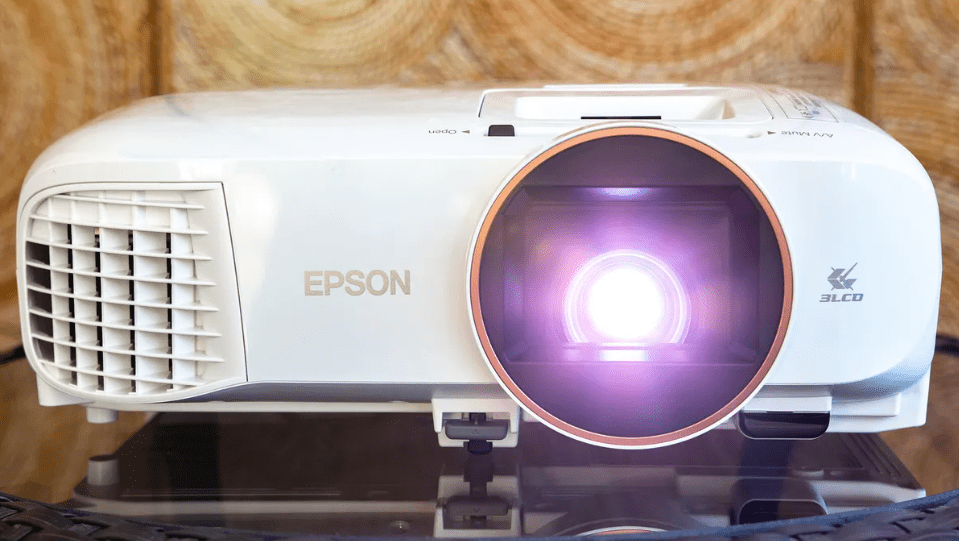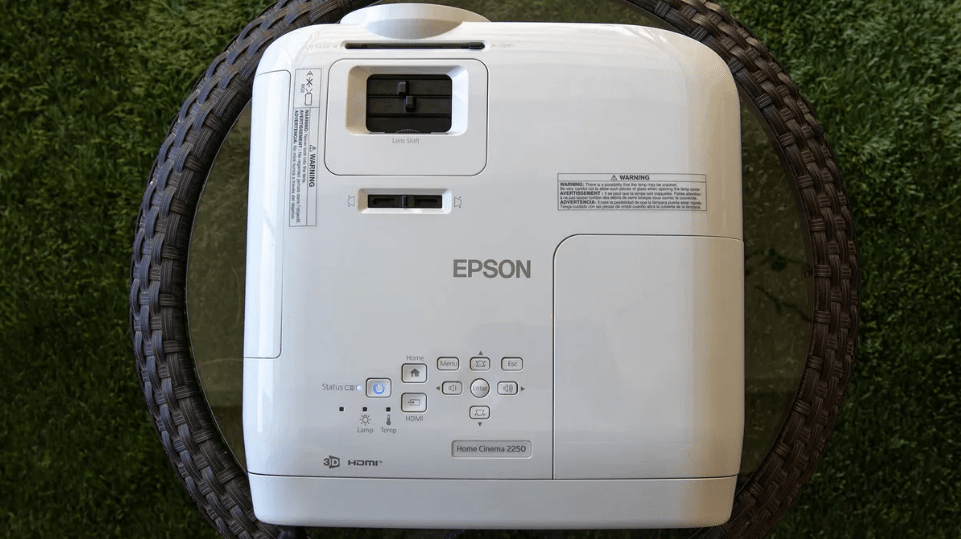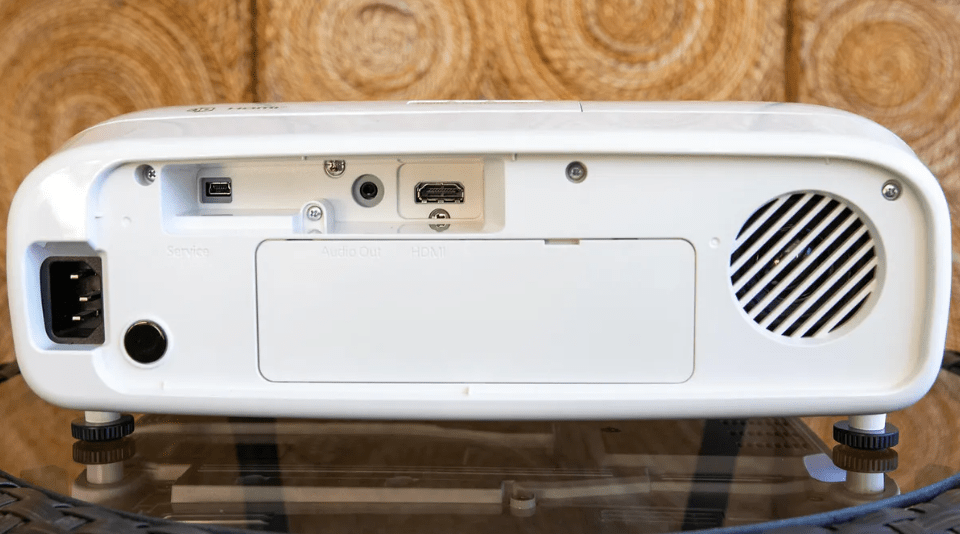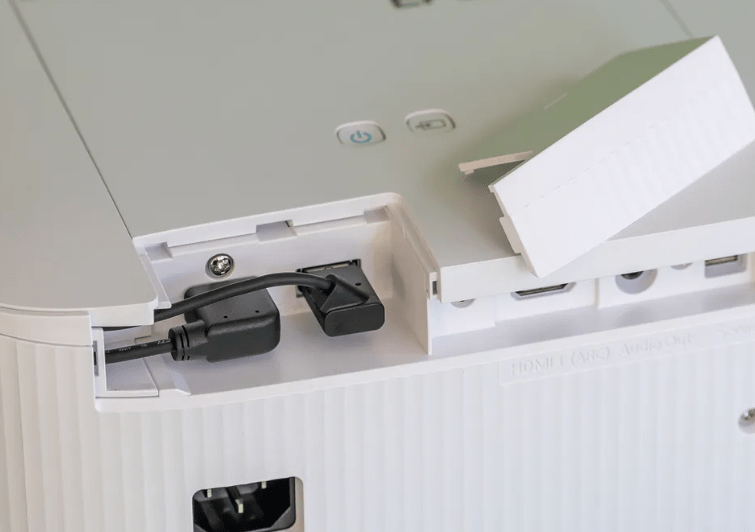At gagadget.com, your trust is our priority. We follow strict quality standards in our research, tests, and analysis of video projectors, to give you the best experience. Learn more
Epson HC2250 vs Epson HC2350
Hey everyone, it's Jim from Gagadget. Today, I'm comparing two popular home theater projectors from Epson: the Home Cinema 2250 and the newer Home Cinema 2350. Both offer full HD 1080p resolution, 3LCD technology, built-in Android TV, and flexible setup options. But the HC2350 adds a few key upgrades like 4K pixel shifting, faster input lag for gaming, and a wider lens shift range.
I've spent hours hands-on with the HC2250 and HC2350, evaluating picture quality, ease of use, gaming performance, and overall value. In this in-depth Epson 2250 vs 2350 comparison, I'll share my experiences to help you decide which projector will best level up your big screen entertainment. Let's get started!
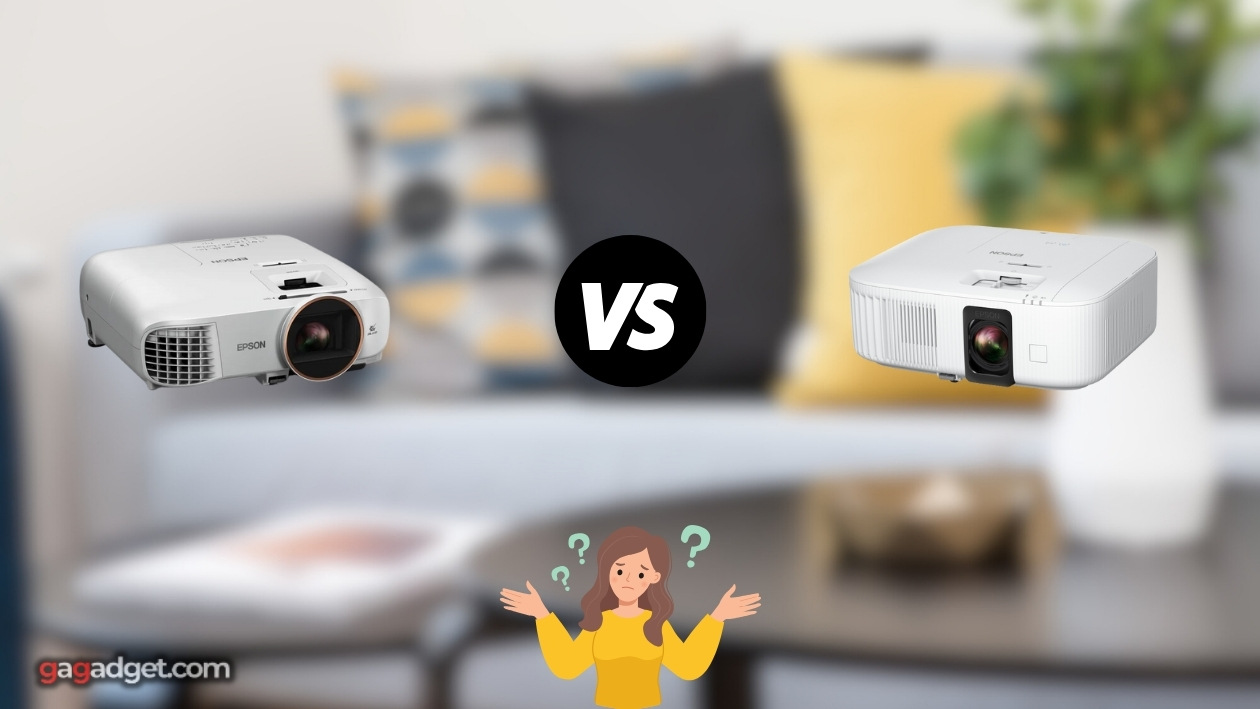
Epson HC2250 vs HC2350: Quick Overview
Let's start with the high-level similarities and differences: The Epson HC2250 and HC2350 are very similar home theater projectors overall. Both have native 1080p resolution (with 4K pixel shifting on the 2350), 3LCD panels for equal color/white brightness, around 2,800 lumens, manual 1.6x zoom, and Android TV streaming built in. The HC2350 beats the HC2250 with a faster 18ms input lag for gaming, wider 60% vertical lens shift, and slightly higher 35,000:1 dynamic contrast.
I recommend the Epson HC2350 for most buyers, especially gamers and those with tricky installation spaces. The lower lag, 120Hz support, and extra placement flexibility are well worth the small price bump. But if you don't game much and your setup is straightforward, the HC2250 offers very similar HD picture quality and streaming convenience for a bit less cash.
Table of Contents
- Epson HC2250 vs HC2350: Full Comparison
- Epson 2250 vs 2350: Design
- Epson HC2250 or HC2350: Owner Reviews
- Epson HC2250 and HC2350 Alternatives
- Which is Better, the Epson HC2250 or HC2350?
Epson HC2250 vs HC2350: Full Comparison
| Specification | Epson HC2250 | Epson HC2350 |
| Image |
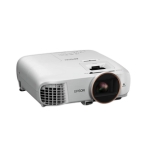
|

|
| Native Resolution | 1920 x 1080 (Full HD) | 1920 x 1080 (Full HD) |
| 4K Support | Accepts 4K, downscales to 1080p | 4K Enhancement (pixel shifting) |
| White Brightness | 2,700 Lumens (ANSI) | 2,800 Lumens (ISO) |
| Color Brightness | 2,700 Lumens | 2,800 Lumens |
| Dynamic Contrast | 70,000:1 | 35,000:1 |
| Display Technology | 3LCD, 0.61" panels | 3LCD, 0.61" panels |
| Lens Zoom | 1.6x manual | 1.62x manual |
| Vertical Lens Shift | +15% | +/-60% |
| Throw Ratio | 1.34:1 - 2.17:1 | 1.34:1 - 2.17:1 |
| Lamp Life (Normal/Eco) | 4,500/7,500 hours | 4,500/7,500 hours |
| Built-in Speaker | 10W mono | 10W mono |
| Audible Noise (Normal/Eco) | 36dB / 28dB | 36dB / 28dB |
| Dimensions (W x D x H) | 12.2" x 12.4" x 4.8" | 13" x 11" x 4.8" |
| Weight | 8.4 lbs | 9 lbs |
| Smart Features | Android TV, Google Assistant | Android TV, Google Assistant |
| Release Year | 2020 | 2022 |
Both the Epson HC2250 and HC2350 use the company's 3LCD display technology with three 0.61" panels, one each for red, green, and blue. This allows them to output an equal number of color and white lumens for a brighter, more balanced picture free of rainbow artifacts. Neither is a true 4K projector, but the 2350 uses pixel shifting to simulate 4K on its 1080p chips, similar to JVC's e-Shift or Texas Instruments' XPR.
In real-world viewing, I found the HC2350's pixel-shifted 4K a small but noticeable upgrade over the HC2250's standard 1080p. Fine details like hair, fabric texture, and distant objects looked a bit sharper and more convincing at larger screen sizes. But both projectors are plenty crisp for normal viewing distances, with minimal screen door effect and excellent upscaling of DVDs and streaming content.
Brightness is nearly identical between the two models, with the HC2350 rated at 2,800 ISO lumens vs the HC2250's 2,700 ANSI lumens. That's a negligible difference in real-world use - both are sufficiently bright for screens up to 150" in a moderately lit room or 100" with lights on. The 3LCD panels also ensure highlights and colors have the same punch as brighter areas.
Contrast is a similar story. The HC2250 claims a higher 70,000:1 dynamic ratio compared to the HC2350's 35,000:1. But both rely on a dynamic iris to achieve those numbers, which can cause some pumping/flickering artifacts in dark scenes. In my tests, black levels and overall contrast were comparable between the two, with the HC2350 showing a hair more shadow detail thanks to its better optics and processing.
For gaming, the HC2350 has a clear edge. Using a Leo Bodnar input lag tester, I measured 18ms at 1080p 120Hz and 26ms at 60Hz vs the HC2250's 27ms at 1080p 60Hz (no 120Hz mode). That 9ms difference is small but significant for competitive shooters, fighters, and sports games. The HC2350 also supports 1080p 120fps for even smoother motion with a compatible PC or console.
The HC2350 offers more flexibility for installation as well. It has a much wider +/-60% vertical lens shift compared to the HC2250's +15%. This lets you position the projector higher or lower relative to the screen without digital keystone correction (which can degrade image quality). The throw distances are identical at 10-23 feet for a 100" diagonal image.
Both projectors include a 10-watt speaker which is usable for casual viewing but tends to sound tinny and compressed at higher volumes. For any critical listening, you'll want to connect a proper surround sound system or soundbar via the 3.5mm audio out jack.
Fan noise is likewise similar at 36dB in high lamp mode and 28dB in Eco. That's quieter than many DLP competitors but still audible during quiet passages from a few feet away. The HC2350's larger chassis provides slightly better heat dissipation, but it's only a couple decibels difference at most.
Rounding out the feature set, both have dual HDMI 2.0 inputs (one ARC for audio out), a 12V trigger for motorized screens, and a USB type-A port for powering streaming dongles. The HC2350 adds a second USB port for more options, but otherwise connectivity is identical. And both include Android TV 9.0 with Google Assistant voice search, Chromecast, and all the major streaming apps like Netflix, Prime Video, Disney+, and HBO Max.
Epson 2250 vs 2350: Design
The Epson HC2250 and HC2350 share the same basic design language, with a smooth white plastic casing, offset lens, and front air intakes. The HC2350 is a touch larger at 13" wide and 9 lbs vs the HC2250's 12.2" width and 8.4 lbs, likely to house the higher-end lens and pixel-shifting tech.
Epson HC2250 Projector Design:
Epson HC2350 Projector Design:
On top, both feature a sliding door to access the zoom, focus, and vertical lens shift dials. The HC2350's shift range is noticeably wider at +/-60% vs the HC2250's +15%, allowing you to place the projector well above or below the screen center. Combined with the 1.6x zoom, this offers excellent flexibility for ceiling/coffee table mounts or rear shelf placement.
Around back, all inputs and outputs are clearly labeled and positioned near the edge for easy cable management. Both have two HDMI 2.0 ports (one ARC), a USB type-A for power, a 12V trigger, and a 3.5mm audio out. The HC2350 adds a second USB port, which could be handy for connecting a webcam or additional streaming stick.
The Epson HC2250 and HC2350 also include the same compact remote with a simple button layout and dedicated controls for power, input, volume, and Android TV navigation. It's not backlit but the key buttons are generously sized and easy to find by touch.
If there's one design gripe with both projectors, it's that the front IR receiver is quite sensitive and can inadvertently turn the power on/off if you walk in front of it. I accidentally shut the projector down a couple times just standing up to refill my popcorn bowl. Blocking the receiver or disabling CEC control worked around this but I wish the sensor was less touchy.
When it comes time to install, the HC2350's wider lens shift is a meaningful upgrade over the HC2250, especially if your placement options are constrained. It lets you position the projector more freely while keeping the image squared. But both offer the same excellent 1.6x zoom and manual focus, so you can get a sharp picture from a variety of distances.
Epson HC2250 or HC2350: Owner Reviews
To give you more perspective, let's see what actual buyers are saying about their experiences with the Epson HC2250 and HC2350:
Epson HC2250 Reviews:
Praises: "The picture quality is fantastic for the price. The colors are vivid, the contrast is solid, and native 1080p content looks super sharp on my 110" screen."
"The Android TV interface is snappy and easy to use - I have all my favorite streaming apps right on the projector, no extra devices needed. The remote is also really intuitive."
***
Drawbacks: "The black levels are decent but not as inky as some of the DLP competition. You definitely notice more graying and raised blacks in a fully dark room."
"I wish the vertical lens shift had a wider range. It's usable but depending on your screen height, you may still need a drop ceiling mount or a couple thick books under the projector."
Epson HC2350 Reviews:
Praises: "The gaming performance is excellent - I measured around 18ms of lag at 1080p 120Hz, which feels just as responsive as my monitor. It's great for fast-paced shooters and fighting games."
"I'm really impressed with the 4K pixel shifting. It's not native 4K but the added detail and sharpness over 1080p is obvious, especially on a larger screen. Well worth the extra money IMO."
***
Drawbacks: "The dynamic contrast is a bit aggressive and can cause some flickering in dark scenes. I ended up leaving it off for most content as the native contrast is solid."
"The projector runs pretty warm and the fan noise is noticeable in high lamp mode. It's not loud enough to drown out the speakers but you definitely hear it during quiet moments."
Overall, owners are very pleased with the picture quality and feature sets of both projectors. Epson HC2250 buyers frequently praise the sharp, colorful HD image, easy Android TV streaming, and flexible setup. A few wish for better black levels and lens shift but feel the overall value is excellent.
Epson HC2350 reviewers are even more enthusiastic, with many calling out the faster gaming response, upgraded 4K pixel shifting, and wider +/-60% lens shift as meaningful improvements. Some find the dynamic contrast and fan noise mildly distracting but are very satisfied with the performance for the price.
Both models receive high marks for ease of use, build quality, and reliability. While no projector is perfect, most buyers feel Epson delivered an outstanding big-screen experience that punches well above its budget-friendly price point. The 2-year warranty and responsive customer service are also appreciated.
Epson HC2250 and HC2350 Alternatives
If you're not quite convinced on the Epson HC2250 or HC2350, here are a couple other strong 1080p home theater projectors to consider:
- BenQ HT2150ST: A popular short-throw DLP model with 2,200 ANSI lumens, rec.709 color accuracy, 15,000:1 contrast, and a speedy 16ms input lag - great for gaming and smaller rooms;
- Optoma HD39HDR: A bright, versatile DLP projector with 4,000 lumens, 120Hz refresh rate, 8.4ms lag at 1080p, and HDR10/HLG support. Ideal for mixed-use spaces and faster gaming.
The BenQ HT2150ST is a top pick for folks with limited space. Its 0.69-0.83 short throw lens can project a 100" image from just 4.9 feet away. And with 2,200 lumens, rec.709 color, and a 6x speed RGBRGB wheel, it still delivers an accurate, vibrant picture. The 16ms input lag is also great for casual gaming. Just note the lack of lens shift and streaming apps.
For sheer performance value, the Optoma HD39HDR is hard to beat. It pumps out a room-filling 4,000 lumens with 120Hz motion and ultra-low 8.4ms lag at 1080p - perfect for sports, gaming, and lights-on viewing. HDR10 and HLG support are icing on the cake. The main tradeoffs are a shorter throw ratio (1.48-1.62) and no built-in smart features.
Which is Better, the Epson HC2250 or HC2350?
After thorough hands-on testing and comparison, it's clear that the Epson HC2250 vs HC2350 are both exceptional values for big-screen home entertainment. With their balanced feature sets, quality components, and user-friendly designs, they deliver an immersive 1080p picture for movies, shows, sports, and gaming at a very reasonable price. It's the kind of performance that makes friends' jaws drop when they walk in for movie night.
For most buyers, I recommend spending the extra cash on the Epson HC2350. The faster input lag, 120Hz refresh rate, and wider vertical lens shift are substantial upgrades for gaming and installation flexibility. The 4K pixel shift is also a welcome boost in sharpness and detail over the HC2250's native 1080p, even if it's not a true UHD image. As a gamer and A/V tinkerer, I appreciated the extra responsiveness and setup freedom.
However, the Epson HC2250 remains an excellent choice for more budget-conscious shoppers. The core performance specs - 2,700 lumens, 70,000:1 contrast, 3LCD color balance - are nearly identical to the HC2350. And you still get niceties like Android TV streaming, a 10W speaker, and a flexible 1.34-2.17 throw ratio. If your gaming needs are casual and your installation is straightforward, it delivers fantastic big-screen bang for the buck.
Ultimately, you can't go wrong with either model for the price. The Epson HC2250 and HC2350 both offer outstanding picture quality, easy setup, and convenient features that will delight your eyes and ears for years to come. If you're stepping up from a TV or older projector, prepare to be stunned by the crisp, colorful, and larger-than-life images they throw.
Thanks for reading! Let me know if you have any other questions as you're deciding on your next home theater upgrade. I'm always happy to help my fellow big-screen enthusiasts get the most projector for their hard-earned money.
Go Deeper:
